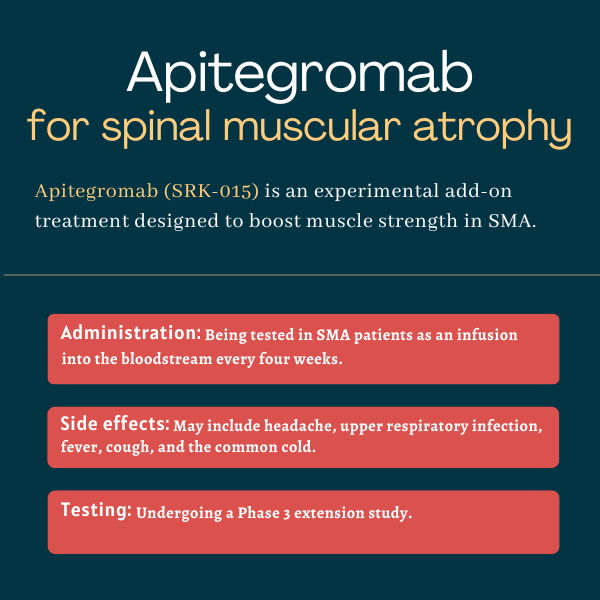Apitegromab (SRK-015) for spinal muscular atrophy
Last updated March 31, 2025, by Marisa Wexler, MS

What is apitegromab for SMA?
Apitegromab (SRK-015) is an experimental muscle-directed infusion therapy being developed by Scholar Rock as an add-on treatment to improve motor function in people with spinal muscular atrophy (SMA).
Apitegromab has received fast track status and orphan drug and rare pediatric disease designations by the U.S. Food and Drug Administration (FDA). It also won orphan medicinal product status and priority medicines eligibility in the European Union. Such designations are intended, in various ways, to speed a therapy’s clinical development.
Therapy snapshot
| Treatment name: | Apitegromab |
| Administration: | Tested in SMA as an intravenous infusion |
| Clinical testing: | Undergoing a Phase 3 extension study |
How does apitegromab work?
In SMA, genetic mutations result in a deficiency of the SMN protein, which leads the nerve cells that control movement, called motor neurons, to sicken and die. This ultimately causes symptoms such as muscle weakness and wasting.
There are several approved disease-modifying treatments for SMA, which work to slow the disease’s progress by increasing levels of SMN.
Apitegromab is being developed as an add-on to SMN-targeting treatments. Rather than addressing the root cause of the disease, apitegromab is designed to boost patients’ muscle strength by targeting the muscle protein myostatin.
Myostatin is primarily present in skeletal muscles — those used for movement — to inhibit muscle growth, thereby helping to maintain a balanced and healthy muscle mass under typical conditions.
Apitegromab is an antibody-based therapy that works by selectively binding to the precursor, or latent form, of myostatin, preventing its conversion into its active, or mature, form. By reducing the levels of mature myostatin, apitegromab should increase muscle mass and improve motor function in people with SMA.
Because apitegromab does not target the active version of myostatin it potentially results in fewer side effects compared with conventional myostatin inhibitors, which can affect other biological processes like bone formation and blood vessel health due to their interaction with related factors.
An early-generation version of SRK-015 was shown to effectively increase muscle mass, boost motor function, and improve bone structure in a mouse model of SMA.
How will apitegromab be administered?
Apitegromab is administered via intravenous (into the bloodstream) infusion. In the SAPPHIRE Phase 3 trial (NCT05156320), which formed the basis of an application for regulatory approval in the U.S., the therapy was given at 10 or 20 mg/kg every four weeks.
Apitegromab in clinical trials
Apitegromab has been tested in a Phase 1 study in healthy volunteers which showed positive safety results and indicated the therapy was blocking myostatin activity as designed. The Phase 2 TOPAZ study (NCT03921528) and the Phase 3 SAPPHIRE trial then followed in people with SMA.
Phase 2 TOPAZ trial
TOPAZ evaluated the safety and effectiveness of two doses of apitegromab (2 or 20 mg/kg) in 58 children and young adults, ages 2-21, with SMA type 2 or type 3 (later-onset disease).
Participants were divided into three groups based on their disease type, and/or ability to walk, and were givenintravenous infusions of apitegromab once every four weeks for up to a year. More than 80% received the higher dose and also were being treated with Biogen’s Spinraza (nusinersen), the first approved SMA disease-modifying therapy.
Results from TOPAZ showed that, after a year, standardized measures of motor function were stable or improved for most patients — a marked contrast from the natural course of SMA, where motor function usually gets progressively worse over time. Some patients had clinically meaningful improvements in motor function after a year on apitegromab, particularly those who were younger at the time the therapy was initiated. Among nonambulatory patients ages 2 and older who had started treatment with Spinraza before age 5, more than half (59%) reported clinically meaningful improvements.
All 57 patients who completed a year of treatment chose to enter the trial’s extension phase where all continued to receive apitegromab for up to an additional year. Two-year data indicated patients’ motor function generally stabilized or further improved after another year on the therapy, and measures of muscle fatigue and life quality also generally were stable or improved. Three-year data continues to show motor function has generally stabilized or improved, with some patients hitting new motor milestones.
At four years, nonambulatory patients again showed continuous improvements, particularly participants ages 12 and younger.
Phase 3 SAPPHIRE trial
SAPPHIRE enrolled 188 people with SMA types 2 or 3 who were on stable treatment with Spinraza or Evrysdi (risdiplam), were unable to walk, but could sit independently. A total of 156 participants ages 2 to 12 were randomly assigned to apitegromab at one of two doses (10 or 20 mg/kg) or a placebo. The remaining 32 patients, ages 13 to 21, were randomly assigned to apitegromab at 20 mg/kg or the placebo.
As in TOPAZ, patients received intravenous infusions of apitegromab once every four weeks for a year.
The study’s main goal was to evaluate the effects of apitegromab on a standardized measure of motor function called the Hammersmith Functional Motor Scale Expanded (HFMSE).
By the end of the study, average HFMSE scores had improved by 0.6 points with apitegromab and worsened by 1.2 points with the placebo — this 1.8-point difference was statistically significant. These benefits of apitegromab were similar across age groups and between the two SMN-targeting therapies.
HFMSE improvements deemed clinically meaningful were seen in more children ages 2 to 12 who took apitegromab than in those on the placebo (30.4% vs. 12.5%). In the younger patients, the results were generally similar with both tested doses.
Other motor function measures, such as assessments of motor milestones and a measure of arm and hand function called the Revised Upper Limb Module, showed trends favoring apitegromab over the placebo. Biomarker data further indicated apitegromab inhibited myostatin as designed.
Ongoing trials
Patients who completed both SAPPHIRE and TOPAZ were eligible to enter the open-label ONYX Phase 3 study (NCT05626855), which is evaluating apitegromab’s long-term safety and efficacy. This study gives all participants, including those who previously received a placebo, the opportunity to be treated with apitegromab.

Common side effects of Apitegromab
In the TOPAZ and SAPPHIRE trials, the most common adverse events included:
- headache
- upper respiratory tract infection
- fever
- cough
- common cold.
The most common serious adverse events in the SAPPHIRE trial, all in patients ages 2-12, were pneumonia (inflammation in the air sacs of the lungs caused by an infection) and dehydration.
SMA News Today is strictly a news and information website about the disease. It does not provide medical advice, diagnosis, or treatment. This content is not intended to be a substitute for professional medical advice, diagnosis, or treatment. Always seek the advice of your physician or other qualified healthcare providers with any questions you may have regarding a medical condition. Never disregard professional medical advice or delay in seeking it because of something you have read on this website.
Related articles






